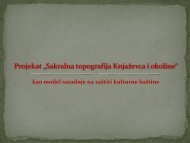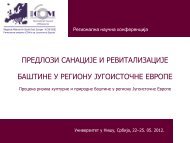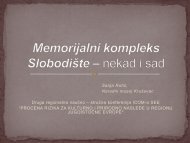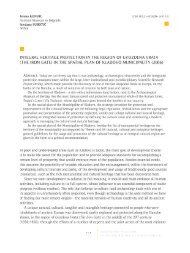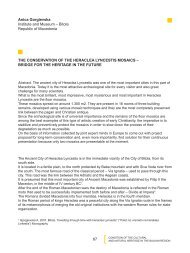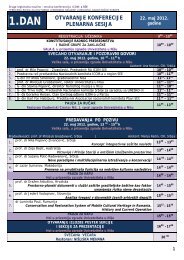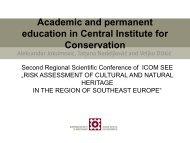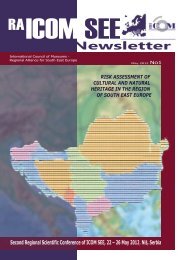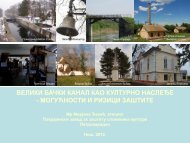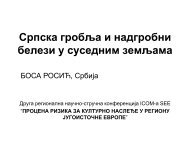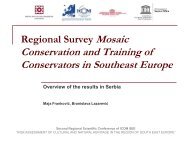Jana Šubic Prislan Nova Gorica Museum Slovenia THE ... - ICOM-SEE
Jana Šubic Prislan Nova Gorica Museum Slovenia THE ... - ICOM-SEE
Jana Šubic Prislan Nova Gorica Museum Slovenia THE ... - ICOM-SEE
Create successful ePaper yourself
Turn your PDF publications into a flip-book with our unique Google optimized e-Paper software.
<strong>Jana</strong> <strong>Šubic</strong> <strong>Prislan</strong><strong>Nova</strong> <strong>Gorica</strong> <strong>Museum</strong><strong>Slovenia</strong><strong>THE</strong> DEVELOPMENT OF CONSERVATION AND RESTORATIONACTIVITIES IN SLOVENE MUSEUMS SINCE 1990Abstract. The conservation and restoration of objects held in Slovene museums has been takingplace ever since museums were established, but this contribution will focus on the development ofthese activities since 1990 in the area led by the Conservation and Restoration Section of the<strong>Museum</strong> Association of <strong>Slovenia</strong>. Individual campaigns and initiatives are presented which havecontributed to improved professional standards and a greater awareness of the conservation andrestoration profession in <strong>Slovenia</strong>, thus affirming its position among activities connected with theprotection of cultural heritage.Conservation and restoration activities in museums are important as they ensure the preservationof collections and facilitate their presentation. Slovene museums have carried out these activities inline with the demands of the time since museums were first established 1 , while this contributionaims to show the development of these activities since 1990, a period for which I have access tothe necessary information, and which I have followed closely and participated in.Since 1970, Slovene museums have been united in the <strong>Museum</strong> Association of <strong>Slovenia</strong> (MAS),an organisation bringing together museums and galleries involved in museum activities asspecified by <strong>ICOM</strong>’s definition. At present, MAS has 64 members and a part of its activities –various joint projects connected with museums – are carried out in sections, the section forconservation and restoration being one of them.The section was founded in 1990. In my annual report for that year I wrote that this was done withthe aim of helping its members “begin to introduce planned training programmes for conservators,together with on-going information provision relating to new procedures and materials; we willorganise translations of foreign literature, themed consultations with visits by Slovene and foreignexperts, and professional excursions; we will jointly import materials and equipment, etc. Theconservation workshop at the National <strong>Museum</strong> will, together with a collegiate body of fourmembers, play the central role”. The expert collegiate body, a kind of a presidency of the section,at first included Zoran Milić, who chaired it until 2000, myself (I have been chairing it since 2000),1 <strong>Jana</strong> <strong>Šubic</strong> <strong>Prislan</strong>, <strong>Jana</strong>ja Slabe: Stari in novi restavratorski posegi – slovenske izkušnje (Old and New RestorationInterventions – Slovene Experiences), a paper read at the working meeting of <strong>ICOM</strong>-CC Glass, Ceramics and RelatedMaterials, Budapest 2001323[CONDITION OF <strong>THE</strong> CULTURALAND NATURAL HERITAGE IN <strong>THE</strong> BALKAN REGION
Irena Porekar Kacafura, Eva Iles and Igor Ravbar, while for short periods we were joined also byTamara Trček Pečak, Alojz Umek and Ivo Nemec. Immediately in the first year we “discussed theemployment and training issues affecting museum conservators and the preparations forpublishing our internal gazette, in which contributions on conservation work and the profession ingeneral would appear, and which would serve as a source of information in the preparation for theprofessional examination”. This is what is said in my reports. I will now go on to describe how werealised all these plans, even though it took us nearly 20 years. All along we worked according to abroad, comprehensive programme, drawn up within the MAS every year, which we tried to makehighly professional, especially in contact with other institutions involved in the protection of culturalheritage in <strong>Slovenia</strong> and abroad. Realisation depended on the finances received from the Ministryof Culture, in connection with which we often felt unjustly overlooked and were consequently oftendissatisfied and demotivated.<strong>Museum</strong> conservators and restorers need a great deal of knowledge and many skills in order to beable to do their work well, but for a long time it seemed that no one appreciated this. We feltmarginalised, ignored and unjustly discriminated against, until we realised that often we ourselveswere not aware of the importance of our role in the process of the protection and preservation ofheritage and that we had to be more proactive. We thought that it was of key importance to appearin public, introduce ourselves, draw attention to our work, get a higher profile and become moreconvincing, thus slowly fulfilling our goals. It was not possible for us to appear as individuals or asa narrow segment of the conservation and restoration activities in <strong>Slovenia</strong>, and thus all of usworking in related institutions and associations sought each other out and united in jointcampaigns. The current dynamic state within the profession is the result of the strivings of all thosewho cared about what tomorrow would bring. We stuck to the principle that initiatives coming fromdifferent directions should be widely supported and this enabled us to successfully carry outnumerous joint projects by combining our financial resources. Although only some of us had theodd sleepless night, all of us throughout <strong>Slovenia</strong> were active: in addition to the conservation andrestoration section within the MAS and the National <strong>Museum</strong> there was also the SloveneRestoration Society, the Restoration Centre, the Academy of Fine Arts – Restoration Department,the Centre for Restoration within the Archive of the Republic of <strong>Slovenia</strong> and individuals inmuseums and galleries.Behind the scenes we took care mainly of the development of the profession, as without firmfoundations and working to a high professional standard all the rest would be unviable. One of thefirst activities that began in 1991 was the joint procurement of equipment and materials for all themuseum conservation and restoration workshops, which was financed by the Ministry of Culture.The collegiate body carefully selected and ordered suitable equipment, a great deal of which hadto come from abroad. Thus most of the workshops over a period of 10 years received micromotors,vacuum driers, digital scales, micro-sanders, polishing machines, the necessaryequipment for sulphite procedures, special lights, various small instruments, chemicals and variousconsumables. When financial support slowly began to dwindle, in order to get a better overview ofthe conditions in conservation and restoration workshops, we drew up a questionnaire that wassent out in 2001 to 26 museums with conservation workshops or museums in which conservationand restoration activities took place. We ascertained what sort of premises they had, how wellequipped they were, what materials they were capable of working on and, above all, what weretheir as yet unfulfilled needs. Even then, some workshops were still very badly equipped andbarely differed from caretakers’ storerooms. I also remember that we asked them what theirexpectations were from this joint project and one of the answers was: “Miracles.” Today I dare saythat we succeeded at least partly and provided an equal supply of basic equipment for all, as well324[CONDITION OF <strong>THE</strong> CULTURALAND NATURAL HERITAGE IN <strong>THE</strong> BALKAN REGION
as making the purchasing of equipment, specialised materials and tools from abroad much easier,as having the right equipment was one of the guarantees of professional work on the part of allthose involved. In 1992 the first programme for computerised conservation and restorationdocumentation was also created, which was replaced in 1998 by a more modern programmecalled Patina, which facilitated the unified management of conservation and restorationdocumentation for those who as yet did not have this facility within their own institution.We also participated in the drawing up of criteria for the obtaining of professional qualifications, asuntil 1992, when we replaced the title curator-conservator with conservator-restorer, we had had toadhere to the same criteria as curators. When dealing with problems connected with our status andorganisation, we looked for comparative situations in other countries. We forged the first contactswith our colleagues abroad when we took part in international gatherings and conferences, and ona few occasions also travelled (to Great Britain, Hungary and Italy) to learn things or at least to findout whether we were thinking along the right lines.In <strong>Slovenia</strong> we felt the lack of gatherings that would enable us to exchange knowledge, informationand opinions, at least informally, and so in 1995 we organised at the National <strong>Museum</strong> workshop aNew Year’s event, a practice which has continued to this day with meetings in different museumsaround <strong>Slovenia</strong>. We got to know our colleagues and their workshops and organised themedlectures. When post and telephone no longer provided sufficiently rapid access to information, wein 2001 “counted” and organised ourselves: all the employees of various workshops throughout<strong>Slovenia</strong> thus had a name and surname, we collected their addresses, phone numbers and e-mailaddresses and messages began to circulate – the same information came to every workshop.Nowadays this unifying role is played by the website of the Slovene Restoration Society, which forall of us represents an important, easily accessible source of information without which we wouldstill be trapped in attics and basements. That is also when we found out that 75 conservatorrestorerswere employed in museum workshops, of which over a half had secondary education andhad been subsequently trained for the job, while the rest had a university degree or a higherspecialisation, the latter in particular in the area of restoring works of visual arts, as this is a specialstudy programme at the Academy of Fine Arts. Considering that most museums are of a rathercomplex character, conservator-restorers have to work on all kinds of museum materials, mostoften on archaeological finds, the quantity of which has further increased in recent years, mainlydue to extensive excavations beneath the new Slovene motorway system. According to the latestunofficial data, the educational structure has improved, but the number of regularly employed hassadly remained the same. This is why it was necessary to strive for additional education of thoseemployed, while also giving young people a chance to obtain institutionalised education in theconservation and restoration of museum objects. In 1995, the first talks were held about theestablishment of a school for museum conservator-restorers, but it is only now, with theintroduction of the Bologna system, that we are about to get a study programme at this level at theRestoration Department of the Academy of Fine Arts. The door for university education relating tomuseums and archives is thus expected to open in the academic year 2012/13. In recent years thenumber of conservator-restorers with a degree or higher level of education in various specialistareas has been increasing, whereas the number of those spending a short period in institutionsabroad or attending courses organised by international organisations or foreign professionalassociations (<strong>ICOM</strong>, ICCROM) is lower.Wanting to acquire new knowledge, we actively participated in the work of related societies in<strong>Slovenia</strong> and helped shape their programme by including our content – let me mention here ourfirst appearance in connection with the Slovene <strong>Museum</strong> Society at the assembly of museum325[CONDITION OF <strong>THE</strong> CULTURALAND NATURAL HERITAGE IN <strong>THE</strong> BALKAN REGION
workers in Dobrna in 1993, when we lectured on the restoration and care of textiles. Since then,we have regularly appeared at various working groups: in 1999, at a meeting in Bohinj we spokeabout standards and in 2003 in Ptuj we talked about educational issues. Our contributions havealways been published together with other professional papers. We have also participated in theorganisation of themed Museoforums.Care has been taken of those who were thirsty for new knowledge or eager to renew old skills:between 2004 and 2006 we organised very well attended cycles of lectures entitled "Chemistry forConservator-Restorers" and "Let's Learn about <strong>Museum</strong> Objects". These lectures were given byour colleagues from museums and by external experts. At the same time we encouraged eachother to report on our work in Argo, various collections of papers and exhibition catalogues, so thatgradually bibliographical units appeared in Slovene in contrast to all the other expert literature thatwas in foreign languages.The most tangible proof of our endeavours in this regard is the publication of the Priročnik zamuzejsko konservatorsko-restavratorsko dejavnost (Manual for <strong>Museum</strong> Conservation andRestoration Activities), started in 2001, which is at the moment the only such reference bookwritten in Slovene. Its origins are in the gazette Fragmenti (1991, two issues), which was a modestbut brave attempt for our voice to reach our colleagues in all the museums. The manual is aimedchiefly at museum employees, which is why every conservator-restorer gets his or her own copy.For the time being, because of the small print run, the publication is not on open sale. Every year,we invite specialist contributions and are thus continually publishing original texts about the generalprinciples and specific procedures of the conservation and restoration of museum objects withregard to the material they are made from, the technology of processing raw materials and themaking of objects, about various techniques and other professional themes – and this is how twoextensive registers are gradually taking shape. This year, the 8th booklet was published, which forthe first time touches upon work in galleries and with it the number of contributions has risen toover thirty. In addition, we are considering how to make it more widely accessible, as it is clear itwould be a valuable source of information when preparing for professional examinations.As mentioned earlier, we also thought it necessary to begin presenting our work regularly to thewider public. One of the first public appearances was at the second Slovene <strong>Museum</strong> Fair in 1994at the Cankarjev dom conference centre. Under the leadership of the conservation and restorationdepartment of the National <strong>Museum</strong>, which has always played a leading role in museumconservation and restoration activities and continues to do so, there was an exhibition entitled"Behind the Scenes in <strong>Museum</strong>s", alongside which a leaflet was published, presenting our work tothe public. In 2001 we began organising the Spring Professional Meeting of Conservator-Restorersand as I was opening the first such event with an exhibition of posters in the National <strong>Museum</strong>, Isaid I found it hard to imagine, but nonetheless hoped that we would at some time be joined byhigh ranking representatives from the Ministry of Culture and colleagues from abroad, and aboveall, by people who have something to show and those interested in our work. In spite of theobstacles and disappointing years our perseverance has paid off and in 2008, 71 people attendedthe meeting, each making a poster showing the highly professional and internationally comparableexamples of their work. So far eight meetings have been organised – usually in late May – at whichwe have exhibited posters about our work in the previous year, while the international character ofthis event is created by our colleagues from Croatia, Serbia, Bulgaria, Romania, Italy, Austria andFinland. We have in recent years reciprocated the visit of our Bulgarian colleagues by attendingtheir Conservation Forum in Sophia, while we also occasionally exhibit at the National <strong>Museum</strong> inBelgrade in the Diana Protection Centre. The meeting in <strong>Slovenia</strong> is always accompanied by the326[CONDITION OF <strong>THE</strong> CULTURALAND NATURAL HERITAGE IN <strong>THE</strong> BALKAN REGION
publication of a catalogue with summaries of the posters, while on the opening day various lecturesand presentations take place. In 2008 we joined the event <strong>Museum</strong> Month and with the traditionalmeeting involving posters we helped to create the Conservation-Restoration May Transversal,giving the event a different name – the Nada Seldar Days. Thus these events will from now on bededicated to our deceased colleague who dedicated her professional life to conservation andrestoration, and for many years led the workshop at the National <strong>Museum</strong>. Within this event, manyworkshops around <strong>Slovenia</strong> opened their doors to the public and organised lectures onconservation and restoration. We were also very successful in taking part at the internationalEuropean Heritage Days 2004 with the theme "Conservation and Restoration in <strong>Slovenia</strong>". Thisopportunity was used for local presentations; in addition, we took part in the creation of animportant publication that brought our work closer to the public. Moreover, in 2006 we presentedour work to the student population at the Student Arena at the Ljubljana Exhibition and ConventionCentre, when alongside a presentation of Slovene museums we also showed the conservationrestorationactivities within them, which attracted a great deal of attention. Most of the workshopsnow occasionally open their doors to the public, organise lectures and other presentations of theirwork, including exhibitions, at which those interested in our activities can learn more.In recent years we have been increasingly active within efforts directed at the advancement ofprofessional activities connected with museums, especially with regard to conservation andrestoration. In <strong>Slovenia</strong> we organise conferences and seminars with international attendance. Weare also invited abroad, both as lecturers and presenters, and it is nice to hear the names ofparticular individuals outside <strong>Slovenia</strong>’s borders or see them in foreign expert literature. Withmembership in international organisations such as <strong>ICOM</strong>, ICCROM and ICON, and participation atprofessional conferences we have carried the name of <strong>Slovenia</strong> across its borders by presentingour work and leading working groups. After having attended several triennial <strong>ICOM</strong>-CCconferences, in 2007 we plucked up the courage to organise in <strong>Nova</strong> <strong>Gorica</strong> a conference of the<strong>ICOM</strong>-CC Ceramics and Glass Working Group, which was well received, partly because of thecollection of papers accompanying it. All this is bringing us recognition in professional circles inmuseums and elsewhere and we are increasingly voted onto the leadership bodies of professionalorganisations and appointed to expert commissions and to the boards of institutions. We are nowreaching for the highest professional titles and awards, including since 2008 the award of theSlovene Restoration Society.327[CONDITION OF <strong>THE</strong> CULTURALAND NATURAL HERITAGE IN <strong>THE</strong> BALKAN REGION
<strong>Jana</strong> <strong>Šubic</strong> <strong>Prislan</strong>Goriški muzejSlovenijaRAZVOJ KONSERVATORSKE-RESTAVRATORSKE DEJAVNOSTI VSLOVENSKIH MUZEJIH PO LETU 1990Povzetek. V slovenskih muzejih poteka konservacija in restavriranje muzejskega gradiva že odnjihove ustanovitve, v prispevku pa želim prikazati razvoj dejavnosti po letu 1990 v tistemsegmentu, ki ga vodi Sekcija konservatorjev-restavratorjev pri Skupnosti muzejev Slovenije.Predstavljam posamezne akcije in pobude, ki so prispevale k dvigu strokovnosti in večjiprepoznavnosti konservatorske-restavratorske stroke v Sloveniji in tako utrdile njen položaj meddejavnostmi za varovanje kulturne dediščine.Konservatorska-restavratorska dejavnost je vmuzejih pomembna, saj zagotavlja ohranjanjazbirk in omogoča njihovo prezentacijo. Vslovenskih muzejih je potekala, času primerno,že od njihove ustanovitve 1 , v pričujočemprispevku pa želim prikazati razvoj dejavnosti poletu 1990, za katero so mi dostopni podatki insem ji sledila in jo tudi soustvarjala.Slovenski muzeji so od leta 1970 združeni vSkupnosti muzejev Slovenije (SMS), povezovalniorganizaciji muzejev in galerij, ki po <strong>ICOM</strong>ovidefiniciji opravljajo muzejsko dejavnost. Trenutnoima 64 članov in del aktivnosti – različnih skupnihprojektov na področju muzejske dejavnosti -izvaja preko sekcij; sekcija konservatorjev –restavratorjev je ena izmed njih.Sekcija konservatorjev-restavratorjev priSkupnosti muzejev Slovenije (SMS) je bilaustanovljena leta 1990 z namenom, da bi člani,dobesedno - kot sem tedaj napisala v svojemletnem poročilu, »pričeli uvajati načrtnoizobraževanje konservatorjev s sprotniminformiranjem o novih postopkih, materialih;organizirali bomo prevode tuje literature,tematska posvetovanja z obiski domačih in tujihstrokovnjakov, strokovne ekskurzije; skupnobomo nabavljali materiale in opremo iz uvoza,ipd. Delavnica Narodnega muzeja bo pri temopravljala matično funkcijo s pomočjoštiričlanskega kolegija.« V strokovnem kolegiju,nekakšnem predsedstvu sekcije, smo bili odzačetka aktivni Zoran Milić, ki je kolegij vodil doleta 2000, mag. <strong>Jana</strong> <strong>Šubic</strong> <strong>Prislan</strong>, ki ga vodimod tedaj dalje, ter Irena Porekar Kacafura, mag.Eva Ilec in Igor Ravbar, za krajša obdobja pa šemag. Tamara Trček Pečak, Alojz Umek in IvoNemec. Že prvo leto smo »...govorili oproblematiki zaposlovanja in izobraževanjamuzejskih konservatorjev in o pripravah zaizdajanje internega glasila, v katerem bi biliobjavljeni prispevki, ki se vsebinsko tičejokonservatorskega dela in stroke nasploh in ki bi1<strong>Jana</strong> <strong>Šubic</strong> <strong>Prislan</strong>, <strong>Jana</strong>ja Slabe: Stari in novi restavratorski posegi – slovenske izkušnje, referat na delovnem srečanju<strong>ICOM</strong>-CC Glass, Ceramics and Related Materials, Budimpešta 2001328 [CONDITION OF <strong>THE</strong> CULTURALAND NATURAL HERITAGE IN <strong>THE</strong> BALKAN REGION
hkrati služil za pripravo na strokovni izpit«. Vse toje bilo črno na belem napisano v mojih poročilih.V nadaljevanju bom opisala, kako smo vse torealizirali, čeprav je bilo potrebnih skoraj 20 let.Ves čas smo delovali po široko zastavljenemprogramu, ki smo ga v okviru SMS pripravilivsako leto in je vseskozi skušal biti visokostrokoven, posebej v stikih z drugimi inštitucijamiza varstvo kulturne dediščine v Sloveniji in tujini.Realizacija je bila odvisna od sredstev, ki nam jihje namenjalo Ministrstvo za kulturo, pri delitvikaterih smo se prevečkrat čutili krivično prezrtein smo bili zato pogosto nezadovoljni inobupani.Muzejski konservatorji-restavratorji za dobroopravljeno delo na predmetih kulturne dediščinepotrebujemo številna znanja in spretnosti, zakatere se je dolgo zdelo, da jih nihče ne ceni.Čutili smo se odrinjene, preslišane in po krivicizapostavljene, dokler nismo ugotovili, da se tudisami pogosto ne zavedamo pomembnosti svojevloge v procesu varovanja in ohranjanjadediščine in moramo sami več narediti zase.Ključnega pomena se nam je zdelo to, dastopimo v javnost, se predstavimo, opozorimo nasvoje delo, postanemo bolj prepoznavni inprepričljivi in tako počasi pričnemo uresničevatisvoje cilje. Ker nas je malo, nismo moglinastopati posamezno oz. kot ozek segmentkonservatorske-restavratorske dejavnosti vSloveniji, pač pa smo se v sorodnih inštitucijah indruštvih poiskali ter povezali med seboj v skupnihakcija, in današnje živahno dogajanje v stroki jerezultat prizadevanj nas vseh, ki nam ni bilovseeno, kaj nam bo prinesel jutri. Držali smo senačela, da so bile pobude, ki so prihajale z večstrani, čim širše podprte, in tako so bili lahko, tudizaradi združevanja finančnih sredstev, uspešnoizpeljani številni skupni projekti. Nekateri izmednas so sicer prebedeli kakšno noč, a v bistvusmo bili dejavni vsi, širom Slovenije: poleg sekcijekonservatorjev - restavratorjev pri SMS inNarodnega muzeja Slovenije še Društvorestavratorjev Slovenije, Restavratorski center,Akademija za likovno umetnost - smerrestavratorstvo, Center za restavriranje pri ArhivuRepublike Slovenije ter posamezniki v muzejih ingalerijah.V zakulisju smo ves čas predvsem skrbeli zarazvoj stroke, saj brez trdnih temeljev in dela navisokem strokovnem nivoju vse to ne bi bilomogoče. Ena prvih akcij, ki je stekla leta 1991, jebila skupna nabava opreme in materialov za vsemuzejske konservatorske-restavratorskedelavnice, ki jo je podprlo in financiraloMinistrstvo za kulturo. Kolegij je skrbno izbral innabavil primerno opremo, veliko tudi iz uvoza, invečina delavnic je postopno, v obdobju 10 let,dobila mikromotorje, vakumske sušilnike,elektronske tehtnice, mikropeskalnike, polirnestroje, potrebno opremo za sulfitni postopek,posebne luči, razno drobno orodje, kemikalije,razen potrošni material in še bi lahko naštevala.Ko je akcija počasi izgubljala finančno podporo,smo za boljši pregled stanja v začetku leta 2001,v želji po boljšem pregledu delovanja muzejskihkonservatorskih-restavratorskih delavnic,pripravili vprašalnik, ki smo ga poslali v 26muzejev, ki so takrat imeli konservatorskerestavratorskedelavnice oz. je tam potekala tadejavnost. Ugotavljali smo v kakšnih prostorihpoteka delo, kako so opremljeni, za obdelavokaterih gradiv so usposobljeni, ... ter predvsem,kakšne so še njihove potrebe. Nekateredelavnice so bile še takrat tako zelo slaboopremljene, da so se komaj razlikovale odhišniških skladišč. Spominjam se, da smospraševali tudi kaj pričakujejo od skupne akcije inje bil eden od odgovorov: »Čudeže«. Danes siupam trditi, da nam je to vsaj deloma uspelo insmo zagotovili zelo enak nivo osnovneopremljenosti vseh ter v tem času olajšali nabavoopreme, specialnih materialov in orodja iz tujine,saj je bila to ena od garancij za dobro delo vseh.Leta 1992 je bil pripravljen tudi že prvi programza konservatorsko-restavratorsko računalniškodokumentacijo, kateri je bil leta 1998 zamenjan ssodobnejšim programom Patina, ki je omogočilenotno vodenje konservatorske-restavratorskedokumentacije tudi tistim, ki to še niso imeliurejeno v okviru svoje institucije.Sodelovali smo tudi pri pripravi kriterijev zapridobivanje naših strokovnih kvalifikacij, saj smobili do leta 1992, ko smo naziv kustoskonservatorzamenjali za konservator-restavrator,podvrženi istim kriterijem kot kustosi. Ko smo se329 [CONDITION OF <strong>THE</strong> CULTURALAND NATURAL HERITAGE IN <strong>THE</strong> BALKAN REGION
srečevali s svojimi statusnimi in organizacijskimiproblemi, smo večkrat iskali primerjave pri kolegihv tujini. Prve stike z njimi smo navezali, ko smo seudeleževali mednarodnih srečanj in konferenc,nekajkrat pa smo se odpravili v tujino (VelikaBritanija, Madžarska, Italija), da se kaj naučimo, alisamo ugotovimo, da razmišljamo pravilno.V Sloveniji pa smo pogrešali razne oblikedruženj, ki bi nam omogočili vsaj neformalnoizmenjavo znanja, informacij in mnenj, zato smoleta 1995 v delavnici Narodnega muzejaorganizirali novoletno srečanje, kakršna so se dodanes nadaljevala s tradicionalnim srečevanjemv muzejih po vsej Sloveniji. Tako smo spoznavalidelavnice in kolege in pripravljali tematskapredavanja. Ko pošta in telefon nista večomogočala dovolj hitrega dostopa do informacij,smo se leta 2001 »prešteli« in organizirali:zaposleni v posameznih delavnicah širomSlovenije so dobili ime in priimek, zbrali smonaslove, telefonske številke, naslove elektronskepošte in pričela so krožiti sporočila - informacija jeodslej prihajala v vsako delavnico. Danes je topovezovalno vlogo prevzela internetna stranDruštva restavratorjev Slovenije, ki je za nas vsepomemben, lahko dostopen vir informacij, brezkaterih bi bili danes še vedno ujeti na podstrešjihin v kleteh. Takrat smo tudi ugotovili, da je vmuzejskih delavnicah zaposlenih 75konservatorjev-restavratorjev, med katerimi je bilasicer dobra polovica priučenih s V. stopnjoizobrazbe, ostali pa diplomirani (VII. stopnja) inspecialisti (VIII), zadnji predvsem na področjurestavriranja likovne dediščine, kar je že vrsto letomogoča študijski program na Akademiji zalikovno umetnost. Glede na to, da je večinamuzejev kompleksnega značaja, konservatorjirestavratorjidelujejo na vseh vrstah muzejskegagradiva, najštevilčnejše pa je arheološko gradivo,katerega količina se je v zadnjih letih šepovečala, predvsem zaradi obsežnih inintenzivnih izkopavanj pod novim slovenskimcestnim križem. Po zadnjih neuradnih podatkih, kiso mi na voljo, se je sicer izobrazbena strukturanekoliko izboljšala, število redno zaposlenih pase v vseh teh letih žal ni povečalo. Zato je bilonujno, da si prizadevamo za izobraževanje žezaposlenih in istočasno mladim omogočimoinstitucionalno izobraževanje na področjukonseraviranja in restavriranja muzejskihpredmetov. Že leta 1995 so stekli prvi pogovori oustanovitvi šole za muzejske konservatorjerestavratorje,a šele z bolonjsko prenovoprograma na Akademiji za likovno umetnost -oddelek za restvaratorstvo, smo po dolgoletnihprizadevanjih tik pred tem, da bo potrjendrugostopenjski študij in se odprejo vrata tudi zamuzejsko-arhivsko področje, predvidoma vštudijskem letu 2012/13. V zadnjih letih se večaštevilo konservatorjev-restavratorjev, ki dosegajoVII. in višjo stopnjo izobrazbe z različnihspecialističnih področij; manj številni so tisti, ki jimuspe, da krajše obdobje preživijo v inštitucijah vtujini ali se udeležijo tečajev, ki jih organizirajomednarodne organizacije ali tuja stanovskadruštva (<strong>ICOM</strong>, ICCROM).V želji po pridobivanju novih vedenj smo seaktivno vključili v delo slovenskih stanovskihdruštev in sooblikovali njihov program s svojimivsebinami – naj pri Slovenskem muzejskemdruštvu omenim prvo sodelovanje na Zborovanjumuzealcev v Dobrni leta 1993, ko smo pripravilipredavanja o restavriranju in negi tekstila. Odtlejsmo precej redno nastopali v raznih delovnihskupinah: leta 1999 smo na srečanju v Bohinjupripravili temo o standardih in leta 2003 smo naPtuju govorili o problemu izobraževanja. Našiprispevki so bili vselej tudi objavljeni skupaj zostalimi strokovnimi prispevki. Sodelovali smotudi pri organizaciji tematskih Muzeoforumov.Poskrbljeno je bilo tudi za tiste, ki so bili željninovega znanja ali utrjevanja starega: v letih 2004- 06 smo organizirali zelo dobro obiskane ciklusepredavanj z naslovom Kemija za konservatorjerestavratorjein Spoznajmo muzejski predmet, kiso jih za nas pripravili kolegi iz muzejskih vrst invabljeni zunanji strokovnjaki. Istočasno smovzpodbujali drug drugega, da smo o svojem deluporočali v Argu, raznih zbornikih in katalogihrazstav, tako da so počasi nastajale bibliografskeenote v slovenščini, medtem ko je bila vsa ostalastrokovna literatura v tujem jeziku.Najbolj oprijemljiv dokaz naših prizadevanj zaboljše znanje pa je od leta 2001 dalje izdajanje330 [CONDITION OF <strong>THE</strong> CULTURALAND NATURAL HERITAGE IN <strong>THE</strong> BALKAN REGION
Priročnika za muzejsko konservatorskorestavratorskodejavnost, ki je trenutno ediniučbenik v slovenskem jeziku. Izšel je iz glasilaFragmenti, ki je bil skromen (1991, dve številki) adrzen poskus, da bi naš glas dosegel kolege vvseh muzejih. Priročnik je namenjen predvsemzaposlenim v muzejih, zato ima vsakkonservator-restavrator svoj izvod, zaradi nizkenaklade pa ga zaenkrat ni mogoče kupiti na trgu.Vsako leto povabimo k sodelovanju specialiste zadoločena področja in tako postopno načrtnoobjavljamo izvirna besedila o splošnih principih inkonkretnih postopkih konserviranja inrestavriranja muzejskih predmetov glede namaterial izdelave, o tehnologiji predelave surovinter izdelave in obdelave predmetov, o tehnikahter drugih strokovnih temah - in tako sepostopoma polnita dva zajetna registratorja. Vletošnjem letu je izšel 8. snopič, ki tematsko prvičposega tudi na galerijsko področje in z njim ještevilo prispevkov preseglo trideset. Razmišljamotudi o tem, kako bi omogočili njegovo širšodostopnost, saj se kaže tudi kot dragocenogradivo za strokovne izpite.Kot sem že omenila, se nam je zdelo nujno tudi,da pričnemo svoje delo redno predstavljatijavnosti. Eden prvih javnih nastopov je bil na 2.slovenskem muzejskem sejmu leta 1994 vCankarjevem domu. Pod vodstvomkonservatorskega-restavratorskega oddelkaNarodnega muzeja Slovenije, ki je imel že prej inima tudi od tedaj dalje vodilno funkcijo v muzejskikonservatorski-restavratorski dejavnosti, je bilapripravljena razstava Za kulisami muzejev, obkateri je izšla tudi zloženka, ki je javnostipredstavila naše delo. Leta 2001 smo pričeli zorganizacijo Pomladnega strokovnega srečanjakonservatorjev-restavratorjev in ko sem otvarjalaprvo srečanje z razstavo plakatov v Narodnemmuzeju Slovenije, sem težko verjela - pa vendarsem upala, da se nam bodo kdaj pridružili tudivisoki predstavniki Ministrstva za kulturo in kolegiiz tujine, predvsem pa čimveč tistih, ki imajo kajpokazati ali tistih, ki jih naše delo zanima. Kljubpreprekam in slabim letinam se nam je vztrajnostobrestovala, in leta 2008 je bilo 71 udeležencev,ki so pripravili plakat s predstavitvijo visokostrokovnih in mednarodno primerljivih primerovsvojega dela. Doslej je bilo organizirnih osemsrečanj, na katerih smo praviloma konec majapostavili na ogled plakate o svojem delu vpreteklem letu, k mednarodnemu značajuprireditve pa zadnja leta prispevajo kolegi izHrvaške, Srbije, Bolgarije, Romunije, Italije,Avstrije, Finske. Bolgarskim kolegom tudi zadnjaleta vračamo udeležbo na njihovemu ForumConservation v Sofii, občasno razstavljamo tudi vOddelku za preventivno zaščito Diana vNarodnem muzeju v Beogradu. Srečanje že vsaleta spremlja tudi publikacija – katalog s povzetkiplakatov, na dan otvoritve pa organiziramorazlična predavanja in predstavitve. V letu 2008smo se vključili v Mesec muzejev in stradicionalnim srečanjem s plakati sooblikovaliKonservatorsko-restavratorsko majskotransverzalo in dogodku dali novo ime - DneviNade Sedlar, ki bodo odslej posvečeni preminulikolegici, ki je svoje življenjsko delo z dolgoletnimvodenjem konservatorske delavnice v Narodnemmuzeju posvetila stroki. V okviru dogajanja so vštevilnih delavnicah po Sloveniji potekali dneviodprtih vrat in strokovna predavanja na temokonserviranje in restavriranje. Posebno uspešnismo bili tudi s sodelovanjem pri mednarodnihDnevih evropske kulturne dediščine 2004 natemo Konservatorstvo in restavratorstvo naSlovenskem, ki so ga številni izkoristili zapredstavitev na svojem terenu. Sodelovali smotudi pri nastanku pomembne publikacije, ki jenaše delo približala javnosti. Študentski populacijismo se posebej predstavili leta 2006 naŠtudentski Areni na Gospodarskem razstavišču,ko smo hkrati s predstavitvijo slovenskih muzejevpredstavili konservatorsko-restavratorskodejavnost, kar je vzbudilo precejšnje zanimanjemed mladimi. Večina delavnic danes občasnoodpira svoja vrata, pripravlja predavanja in drugepredstavitve svojega dela, tudi razstave, nakaterih lahko zainteresirani spoznajo naš poklic.Zadnja leta se vse bolj aktivno vključujemo vprizadevanja za napredek muzejske stroke,posebej še za konservatorstvo-restavratorstvo.Na domačih tleh organiziramo konference inseminarje z mednarodno udeležbo. Vabljeni smov tujino kot predavatelji in demonstratorji. Mednami so seveda nekateri posamezniki bolj aktivni331 [CONDITION OF <strong>THE</strong> CULTURALAND NATURAL HERITAGE IN <strong>THE</strong> BALKAN REGION
in marsikatero ime iz naših vrst lepo zveni, ko gaslišimo izven naših meja ali preberemo v tujistrokovni literaturi. S članstvom v tujih inmednarodnih organizacijah kot so <strong>ICOM</strong>,ICCROM, ICON ipd. in udeležbi na strokovnihkonferencah smo ime Slovenije ponesli prekonaših meja s predstavitvami svojega dela in celoz vodenjem delovnih skupin. Po večkratniudeležbi na trienalnih konferencah <strong>ICOM</strong>-CCsmo se leta 2007 ojunačili in v Novi Goriciorganizirali konferenco <strong>ICOM</strong>-CC Ceramics andGlass Working Group, ki je bila zelo odmevna,tudi zaradi zbornika, ki jo je spremljal. Vse to namprinaša priznanje v muzejskih in drugihstrokovnih krogih in vse bolj pogosto smoizvoljeni v predsedstva stanovskih organizacij inimenovani v strokovne komisije in svete zavodov.Segamo tudi po najvišjih svetniških nazivih instanovskih nagradah, od leta 2008 tudi ponagradi Društva restavratorjev Slovenije.1Figure 1 The opening of Spring Professional Meeting ofConservator-Restorers in National <strong>Museum</strong> of <strong>Slovenia</strong>,May 2007 (photo Gorazd Lemajič)Slika 1 Otvoritev Pomladnega strokovnega srečanjakonservatorjev-restavratorjev v Narodnem muzejuSlovenije, maj 2007 (foto Gorazd Lemajič)332 [CONDITION OF <strong>THE</strong> CULTURALAND NATURAL HERITAGE IN <strong>THE</strong> BALKAN REGION



